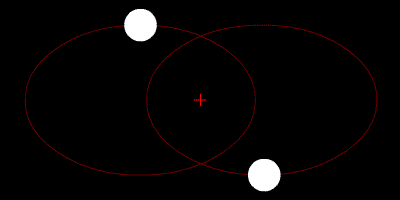Hello, friends!
Today I just want to share a thing that came up during my research for last week’s episode of Sciency Words. It has to do with our next-door neighbors, the Alpha Centauri star system.
Alpha Centauri is, famously, the nearest star system to our own Solar System. As such, Alpha Centauri gets a lot of love from science fiction writers. So many space aliens come from there, and so many human space adventurers will be heading Alpha Centauri’s way, just as soon as we invent faster-than-light technology.
Alpha Centauri is also, famously, a binary star system: two stars locked in orbit together1. But the way the Alpha Centauri binary is portrayed in science fiction is… well, I think a lot of Sci-Fi writers get this wrong. I know I’ve gotten it wrong in the past.
Which brings me to the thing I want to share with you today. It’s a simple but absolutely perfect visualization of the way Alpha Centauri A and B dance around their common center of mass (a.k.a. their barycenter).

In my experience, a lot of science fiction writers make it sound like Alpha Centauri A and B are right next to each other. They make it sound like you could stand on the surface of a planet, look up, and see two suns side by side, like you’re Luke Skywalker watching the double sunset on Tattooine.
But even at closest approach, Alpha Centauri A and B are approximately 11 astronomical units apart (roughly equivalent to the distance between the Sun and Saturn). And at maximum separation, they’re approximately 36 astronomical units apart (roughly equivalent to the distance between the Sun and Pluto).
Yes, watching a double sunset like that scene in Star Wars would be incredible. But this figure-eight dance that happens in Alpha Centauri (and in many other binary star systems too) is even more amazing, in my opinion.
Next time on Planet Pailly, we’ll meet some insects who would really appreciate it if we’d change their name already.
1 Umm, actually Alpha Centauri has three stars: two Sun-like stars in the middle and a tiny red dwarf star orbiting much farther out.
It seems like the Luke Skywalker visage, along with many other cool science fiction type scenes, isn’t very plausible. There may be scenarios where that exact sight happens, but I wonder how habitable a planet with it would be.
Proxima centauri actually orbits much further out, like a fifth of a light year if I recall correctly. I remember reading somewhere that astronomers aren’t completely certain that it’s gravitationally bound to Centauri A and B. (Although maybe that’s been firmed up over time.) If it is, its orbit is like something like half a million years.
LikeLiked by 2 people
I was reading up on Proxima for this post, and it sounds like there’s more certainty than there used to be that Proxima is gravitationally bound to Alpha Centauri A and B. Also, Proxima may have two planets, one confirmed and another that may be confirmed soon.
LikeLiked by 2 people
Could a Goldilocks planet orbit such an arrangement? If you find the time, I’d love read about what it would take. A sketch would be nice too. 😉
Anna from elements of emaginette
LikeLiked by 3 people
I doubt it. Every time those two stars approach each other, they’d try to yank that poor Goldilocks planet out of orbit.
But it would definitely make for an interesting post.
LikeLiked by 2 people
I spoke too soon. I just found two papers through Google Scholar on possible planets in the habitable zone of Alpha Centauri B. So I’ll read those papers and do a post on what I find out.
LikeLiked by 2 people
Yay!
LikeLiked by 1 person
The way so many of us see the universe is wrong and yet we think we’re starting to understand it.
LikeLiked by 1 person
I’d say we understand the universe better than we once did. That doesn’t mean we don’t have a whole lot more to learn yet!
LikeLiked by 1 person
Oh yes…
LikeLiked by 1 person